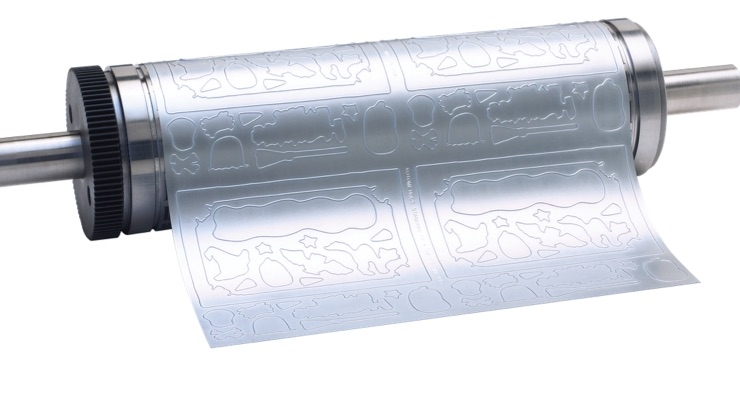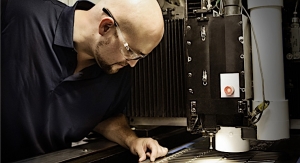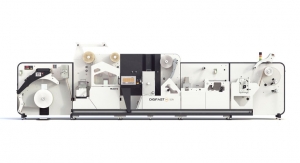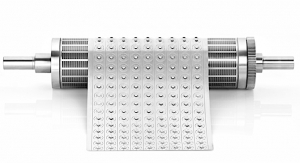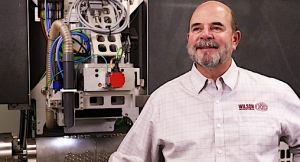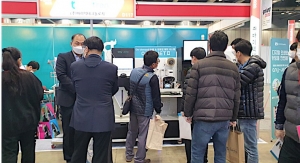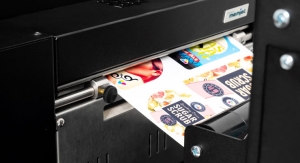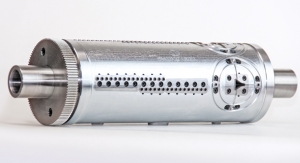Greg Hrinya, Associate Editor02.07.17
RotoMetrics, a designer and manufacturer of precision rotary tooling, including solid and flexible dies, magnetic cylinders, anvils, print cylinders and sleeves, is helping its customers navigate the shift toward flexible dies. As is the case in most areas of the label and narrow web industry, customers are seeking higher quality with shorter lead times.
“We have optimized the manufacturing process to allow us to finish flexible dies in several hours–instead of days,” says Ulrich Kretzschmar, global product and business development at RotoMetrics. “A fair share of the more than 1,100 flex dies we produce daily ship the same day from our manufacturing facilities on five continents. Improved and optimized blade geometries in combination with dedicated finishing processed opened the doors to new opportunities utilizing flexible die technology outside the tag and label markets.”
While Europe has already seen a transition to flexible dies, the growth rate has been a little slower in the Americas. However, the growth of digital printing technology will accelerate the transition to flexible dies. “An always faster moving market environment with frequent design changes and smaller SKU’s, converters are in need of tooling solutions supporting such market trends,” explains Kretzschmar. “Logistics are a critical part in the entire supply chain and converters need cutting tools in a matter of days or even hours. Flexible dies are the answer for those requirements.”
Brand owners, graphic designers and retailers are constantly seeking solutions to reduce waste, convert to thinner materials, and move at faster speeds. Converters also require tighter tolerances and longer lasting solutions. “We, as a tooling supplier, have to reinvent ourselves to keep up with the always changing market requirements,” says Kretzschmar. “Just as an example, plate height tolerances of a rotary cutting tool converting a thin PET liner for beverage labels have to be five times tighter than one for a paper liner, which was the standard not too long ago.”
RotoMetrics does still offer solutions for customers seeking solid tooling, which can still offer an advantage over flexible dies. Solid tooling provides “unlimited” blade height and a wider variety of blade angles. According to RotoMetrics, these benefits will help solid tooling to keep its place in the world of converting outside the tag and label market. These markets include packaging and folding cartons, industrial, automotive, electrical medical and pharmaceutical applications.
“We call these market segments ‘web fabrication,’” explains Kretzschmar. “Applications in these segments utilize a wide variety of different materials, which in return require dedicated and customized tooling solutions. And this is where our experienced team of application advisers and engineers do make the difference and design the best possible solution.”
In order to successfully help its customers, RotoMetrics has to go beyond just offering finishing tools. The company provides a dedicated support team of application advisors, engineers, master technicians, craftsmen and specialists in locations where converters are doing business. RotoMetrics also boasts a 99% on-time delivery, as well as precise solutions that work right the first time.
According to the company, timely support maximizes uptime. “Time is becoming the most critical part in the equation,” says Kretzschmar. “RotoMetrics has transformed itself from a traditional tooling manufacturer into a global service provider with continuously evolving products and practices for solutions that work right the first time. We also provide online order and tracking tools like MyRoto to give our customers a 24/7 service to help them excel in a fast pace environment.”
With the wide range of substrates available on the market, utilizing the proper tooling is a critical aspect of rotary diecutting. Therefore, RotoMetrics strives to develop the right tools before the launch of new materials. Kretzschmar adds that this is a service converters should request from their suppliers. “It’s tough for converters to keep up with new technologies and all the frequent changes of materials, substrates, inks, coatings and so on,” he says. “They rely on a well-connected supplier network with business partners offering reliable solutions and products extensively tested to exceed industry standards that work out of the box the first time, every time.”
Thinner liners require tighter plate height tolerances while optimized face materials have an impact on the overall blade geometry like blade angles, blade flat and more. Specialty (non-stick) coatings help avoid adhesive build up on the blade and stabilize the converting process. “RotoMetrics owns the industry’s most extensive materials database to ensure a perfect cut on any substrate,” concludes Kretzschmar. “And we keep this database the most up-to-date due to continuous R&D together with all leading material suppliers.”
“We have optimized the manufacturing process to allow us to finish flexible dies in several hours–instead of days,” says Ulrich Kretzschmar, global product and business development at RotoMetrics. “A fair share of the more than 1,100 flex dies we produce daily ship the same day from our manufacturing facilities on five continents. Improved and optimized blade geometries in combination with dedicated finishing processed opened the doors to new opportunities utilizing flexible die technology outside the tag and label markets.”
While Europe has already seen a transition to flexible dies, the growth rate has been a little slower in the Americas. However, the growth of digital printing technology will accelerate the transition to flexible dies. “An always faster moving market environment with frequent design changes and smaller SKU’s, converters are in need of tooling solutions supporting such market trends,” explains Kretzschmar. “Logistics are a critical part in the entire supply chain and converters need cutting tools in a matter of days or even hours. Flexible dies are the answer for those requirements.”
Brand owners, graphic designers and retailers are constantly seeking solutions to reduce waste, convert to thinner materials, and move at faster speeds. Converters also require tighter tolerances and longer lasting solutions. “We, as a tooling supplier, have to reinvent ourselves to keep up with the always changing market requirements,” says Kretzschmar. “Just as an example, plate height tolerances of a rotary cutting tool converting a thin PET liner for beverage labels have to be five times tighter than one for a paper liner, which was the standard not too long ago.”
RotoMetrics does still offer solutions for customers seeking solid tooling, which can still offer an advantage over flexible dies. Solid tooling provides “unlimited” blade height and a wider variety of blade angles. According to RotoMetrics, these benefits will help solid tooling to keep its place in the world of converting outside the tag and label market. These markets include packaging and folding cartons, industrial, automotive, electrical medical and pharmaceutical applications.
“We call these market segments ‘web fabrication,’” explains Kretzschmar. “Applications in these segments utilize a wide variety of different materials, which in return require dedicated and customized tooling solutions. And this is where our experienced team of application advisers and engineers do make the difference and design the best possible solution.”
In order to successfully help its customers, RotoMetrics has to go beyond just offering finishing tools. The company provides a dedicated support team of application advisors, engineers, master technicians, craftsmen and specialists in locations where converters are doing business. RotoMetrics also boasts a 99% on-time delivery, as well as precise solutions that work right the first time.
According to the company, timely support maximizes uptime. “Time is becoming the most critical part in the equation,” says Kretzschmar. “RotoMetrics has transformed itself from a traditional tooling manufacturer into a global service provider with continuously evolving products and practices for solutions that work right the first time. We also provide online order and tracking tools like MyRoto to give our customers a 24/7 service to help them excel in a fast pace environment.”
With the wide range of substrates available on the market, utilizing the proper tooling is a critical aspect of rotary diecutting. Therefore, RotoMetrics strives to develop the right tools before the launch of new materials. Kretzschmar adds that this is a service converters should request from their suppliers. “It’s tough for converters to keep up with new technologies and all the frequent changes of materials, substrates, inks, coatings and so on,” he says. “They rely on a well-connected supplier network with business partners offering reliable solutions and products extensively tested to exceed industry standards that work out of the box the first time, every time.”
Thinner liners require tighter plate height tolerances while optimized face materials have an impact on the overall blade geometry like blade angles, blade flat and more. Specialty (non-stick) coatings help avoid adhesive build up on the blade and stabilize the converting process. “RotoMetrics owns the industry’s most extensive materials database to ensure a perfect cut on any substrate,” concludes Kretzschmar. “And we keep this database the most up-to-date due to continuous R&D together with all leading material suppliers.”

